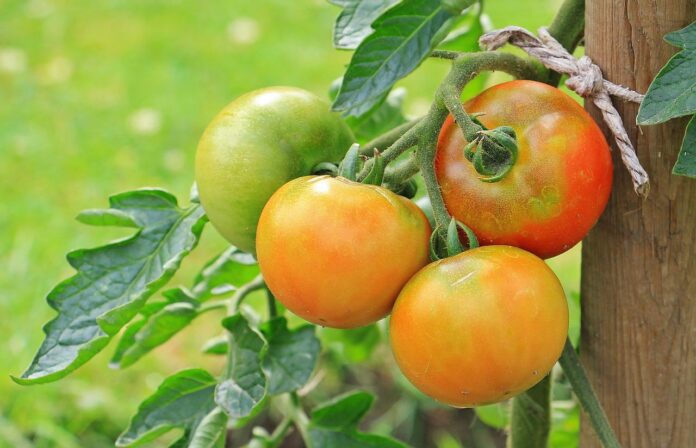Maybe I just don’t pay attention at the supermarket, but I didn’t even realize “vine-ripened” was a selling point for tomatoes. I have always just left tomatoes on the vine until they were red because my mom told me they wouldn’t taste as good if they were picked too soon.
As it turns out, most commercially-produced tomatoes are picked before they take on the entirely red coloration we associate with being ripe. And science says there’s nothing wrong with that. In fact, picking tomatoes before they are completely ripe can be beneficial.
I’m not saying mom is wrong and I’m definitely not condemning grandma’s wisdom or the generations of women in my family to come before them. I’ve just learned there’s an optimal time to pick tomatoes before they’re completely red.
Picking tomatoes at color break can improve their appearance and quality, lengthen their shelf life and increase your harvest.
The science
When tomatoes begin to change color they’ve reached maturity. They’re not going to grow anymore or take any more nutrients from the plant. In fact, a layer of cells forms across the stem of the tomato and seals it off from the main vine and the rest of the plant.
This is called the breaker stage or color break. Tomatoes appear about half green and half pink, red, yellow or orange. These tomatoes will also be softer than the immature green tomatoes on the plant. During this stage, tomatoes can be harvested and ripened off the vine with no loss of flavor quality or nutrition.
Benefits
Harvesting at color break offers several benefits and can potentially even increase your yields.
Removing mature tomatoes from your plants earlier lightens the load on your plant. Too many tomatoes on one plant will slow down the production of new blossoms. By removing full-grown tomatoes sooner and allowing new blossoms to form faster you could increase your yields. Additionally, mature tomatoes weigh down the vines of plants and could potentially cause damage that could impact the plant’s production.
As tomatoes ripen and turn red on the vine, they attract a host of birds, insects and other wildlife. Red is a color associated with food sources for many wildlife. When harvested earlier while they are still ripening, you can reduce the amount of pest exposure and damage to your crop.
Tomatoes that are harvested earlier also sustain less damage from the elements. Allowing tomatoes to stay on the vine longer increases their risk of sun spots and blemishes developing, bruising from a storm or wind and cracking or splitting linked to excessive water following a dry period or too much sun.
Sun exposure can cause increased cracking and splitting in tomatoes left on the vine for too long because they have become overripe. This is also why ripening tomatoes on a windowsill may not be ideal.
Ripening tomatoes indoors
Tomatoes don’t even rely on sun exposure to ripen. They actually ripen best in a shaded location with plenty of air circulation at around 70 F.
The ripening process of tomatoes is regulated by an internal gas produced within the fruit called ethylene. Tomatoes continue to produce ethylene after they have been harvested, allowing them to ripen fully on their own. Ethylene is also naturally released by apples and bananas, so placing a ripe apple or banana with ripening tomatoes can speed up the process.
On a rack. Ripening tomatoes on a bread or baking rack in a cool location out of the sun allows the fruits to continue ripening evenly as they allow air circulation on all sides. However, it may take more time than other methods of ripening.
In a box. Cardboard boxes lined with newspaper are also commonly used to ripen tomatoes. Just make sure to only fill the box with a single layer of tomatoes, spaced out to allow for air circulation. Be sure to check on your ripening tomatoes regularly and remove the ones that are fully ripe. Placing an apple or banana in the box with the tomatoes can help speed up ripening.
In a bag. Ripening fruit in a paper bag is another common method and possibly one of the quickest ways to ripen fruit. However, because of the limited space and less air circulation, there’s an increased risk of mold and rot. If you choose this method, the bag should be checked frequently and no fruits with signs of damage should be placed inside. An apple or banana placed inside the bag will also speed up ripening in this instance.
Hang up the plant. At the end of the season when the threat of frost is near, you may also choose to pull the entire plant and hang it up to allow whatever green tomatoes remain to finish ripening indoors.
Caution
Avoid the refrigerator. A refrigerator is a place for storing and preserving, not ripening. At temperatures of 50 F or below, tomatoes will stop ripening and will never turn red. Additionally, when daytime temperatures struggle to get higher than 50 F at the end of the growing season it’s time to harvest whatever tomatoes remain in your garden and try to finish ripening them indoors.
Don’t pick tomatoes before color break. Tomatoes picked before color break that are completely green and hard will never ripen. Color break signals that a tomato has reached maturity and at that point can produce ethylene and ripen on its own.
So mom wasn’t wrong, tomatoes picked too early probably won’t taste as good (unless they are fried). However, tomatoes picked before they are completely ripe can be delicious.














Nice to know as I was also told to leave them om the plant till they are red..Thanks.
Thanks for the info. Proof that we”re never too old to learn. I never knew about the apple/banana method. FYI: I like to fry my ‘green’ tomatoes st the first sign of color break, while still firm.
I always save all the green tomatoes and take in the basement to ripen. We have had tomatoes from the garden til January. Even cherry tomatoes…
Without reading on this I assumed that when they break the growing is finished and I put them in my North kitchen window, of course no sun, and it works beautifully. Thank you for verifying it for me. I’m sharing this article.